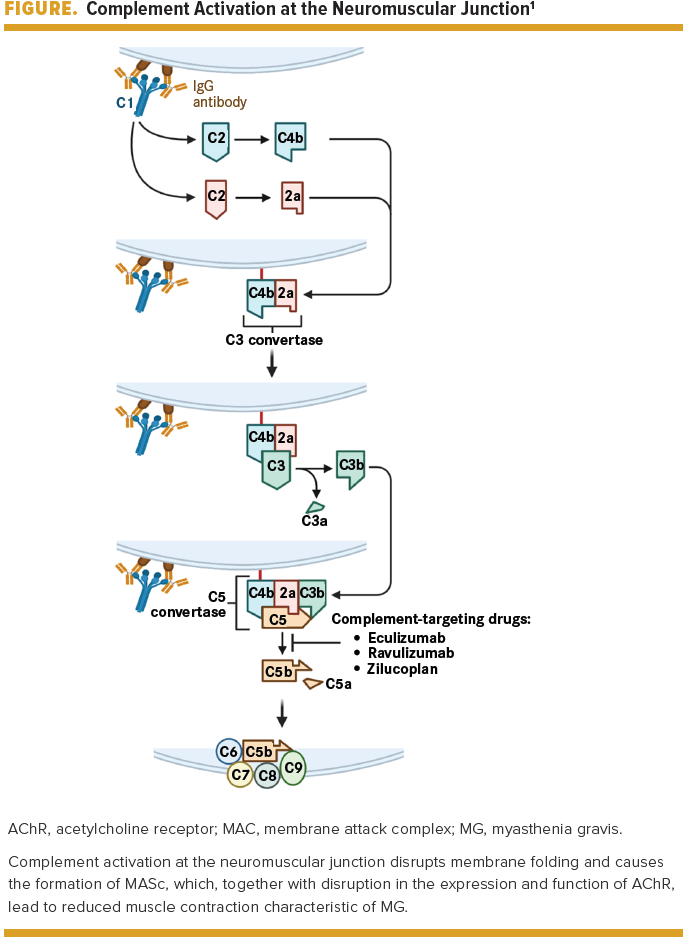Publication
Article
NeurologyLive
Complement Inhibition in Myasthenia Gravis
Author(s):
Recent advancements have the potential to significantly improve the lives of individuals with myasthenia gravis and contribute to the broader understanding of autoimmune diseases

Jennifer S. Sun, PhD

MYASTHENIA GRAVIS (MG) is an autoimmune disease triggered in part by activation of the complement system, typically by autoantibodies that block acetylcholine receptor (AChR) signaling at the neuromuscular junction (NMJ) and thus disrupt synaptic transmission.1 Animal models with complement factor knockouts or deficiencies led to complement deposition at the NMJ, and endplate damage animal models lacking specific complement proteins exhibit reduced MG incidence, supporting the role of the complement system in MG.1,2 Complement-targeting treatments, such as anti-C1q and anti-C6 antibodies, aim to inhibit membrane attack complex (MAC) formation and reduce complement-mediated destruction of the postsynaptic endplate.1,2 Such advancements have the potential to significantly improve the lives of individuals with MG and contribute to the broader understanding of autoimmune diseases.3
The main components of the complement system are the enzymatic cascade and the lytic pathway (FIGURE).1 The enzymatic cascade involves the assembly of convertases, which are enzyme complexes that help activate, assemble, and cleave a series of complement proteins, ultimately generating biologically active proinflammatory molecules that are critical for innate immunity and tissue homeostasis.1 This cascade also produces molecules needed for the lytic pathway, in which complement proteins C5b, C6, C7, C8, and C9 sequentially associate within the cell membrane, forming the MAC. By creating osmolytic pores, the MAC generates a transmembrane channel that allows damage and destruction of the cell. To protect against osmolysis of healthy cells via autologous complement attack, regulatory proteins exist to limit MAC formation. The main complement regulator, CD59, prevents a key step in the process, which is the binding of C9 to the C5b-8 complex.1 C5 cleavage into C5a and C5b is a critical step in MAC formation, which is initiated by C5b.1
Complement inhibition targeting specific complement proteins (eg, C3 and C5) has emerged as a promising therapeutic approach for complement-mediated diseases, including MG.1,4 The primary strategy consists of using monoclonal antibodies to target complement proteins and/or regulators to prevent the formation of the MAC, which normally mediates tissue damage and inflammation.1,3 For example, eculizumab (Soliris; Alexion) is a humanized immunoglobulin G (IgG2/4) monoclonal antibody that functions to inhibit C5 cleavage.1 In one phase 3 clinical trial, the REGAIN Study (NCT01997229), eculizumab yielded significant improvements in disease severity and quality of life for patients with MG.1,5 Eculizumab has been approved for neuromyelitis optica spectrum disorder (NMOSD) treatment.1 Another approach involves the use of complement regulators, such as factor H and CD59, which can prevent MAC assembly.3,6 Overexpression of CD59 in animal models reduced complement-mediated damage at the NMJ and improved muscle function.7 Understanding complement-mediated tissue damage can advise the development of novel therapeutic interventions for neurological disorders.1,8,9

Eculizumab is the first complement-targeting drug approved for complement-mediated diseases.1 The binding of eculizumab inhibits cleavage of C5 into C5a and C5b, which blocks MAC assembly.3,10 Eculizumab’s ability to inhibit MAC formation was effective in treating paroxysmal nocturnal hemoglobinuria (PNH) and atypical hemolytic uremic syndrome, and it was able to reduce relapse risk in NMOSD.3 In a pilot randomized, double-blind, placebo-controlled phase 2 trial (Study C08-00111; NCT00727194), eculizumab showed a therapeutic effect in patients with treatment-refractory generalized myasthenia gravis (gMG), with more patients in the eculizumab cohort (86%) achieving a target reduction in the quantitative myasthenia gravis (QMG) score compared with the placebo group (56%).3 The phase 3 REGAIN study (ECU-MG-3015) and its open-label extension (OLE) study (ECU-MG-302; NCT0230162412) did not meet (P = .0698) its primary end point of improvement to MG Activities of Daily Living (MG-ADL) scores from baseline to week 26. However, eculizumab showed success in the secondary end points of improvement in MG-ADL scores greater than or equal to 3 points and improvement in QMG scores (P = .0129) from baseline to week 26.3 Notably, clinical efficacy appeared early after the first infusion, peaked around week 12, and was sustained throughout REGAIN’s 130-week OLE phase.3 Eculizumab has been approved for treatment of adults with AChR autoantibody–positive gMG in the United States, Europe, and Japan, and a phase 3 OLE study is currently evaluating eculizumab in pediatric participants (NCT03759366).3 Although patients with a history of thymoma or thymic neoplasm were excluded from the REGAIN trial, recent case reports suggest that eculizumab may also be effective in thymoma-associated MG, a patient subset with an elevated incidence of treatment-refractory disease.3
Ravulizumab-cwvz (Ultomiris; Alexion), a longer-acting derivative of eculizumab, has been approved by regulatory agencies for the management of PNH and is being investigated for its potential in treating NMOSD and MG.1 Ravulizumab-cwvz blocks the generation of C5a and C5b to prevent MAC assembly, thereby reducing inflammation and tissue damage.13,14 In the phase 3, open-label CHAMPION 301 trial (NCT0294646315) in PNH, ravulizumab-cwvz was determined to be noninferior to eculizumab in all efficacy end points, including inhibition of C5 activity.13 The safety profile of ravulizumab-cwvz is consistent with that of C5 inhibitors, with common adverse events including headache and nasopharyngitis.16 Patients are also recommended to either receive vaccinations against Neisseria meningitidis, Streptococcus pneumoniae, and Haemophilus influenzae type B, or to be placed on prophylactic antibiotic therapy.16 There were no instances of meningococcal infections during the trial.13 Ravulizumab-cwvz has a longer dosing interval, and the ravulizumab-cwvz cohort had a lower rate of breakthrough hemolysis compared with the eculizumab cohort.13
Zilucoplan is a macrocyclic peptide that binds to C5 and inhibits its cleavage, thereby preventing the formation of C5a and the MAC.3 Zilucoplan is a subcutaneously administered C5 inhibitor that has a rapid onset of action and sustained improvements over 12 weeks, with no serious adverse effects observed.1 A phase 2 double-blind, placebo-controlled trial (NCT03315130) evaluated 12 weeks of daily subcutaneous zilucoplan in patients with AChR autoantibody–positive gMG. A total of 44 participants were randomly assigned 1:1:1 to receive 0.3 mg/kg zilucoplan, 0.1 mg/kg zilucoplan, or placebo.3,9 The zilucoplan cohorts showed significant and clinically meaningful improvement in QMG scores from baseline to week 12, the trial’s primary end point. Notably, near-complete (> 97%) complement inhibition was observed in the higher-dose zilucoplan group.3 In a phase 3 trial (RAISE, NCT0411529317) that completed in 2022, 172 patients with MG were randomly assigned to receive either zilucoplan or placebo.17 The primary end point was the change in MG-ADL score from baseline to week 12.3 Zilucoplan improved the MG-ADL score beyond the clinically meaningful threshold of 3 points in nearly three-quarters of patients compared with just under half of those who received placebo.17 Altogether, zilucoplan’s rapid onset of action, sustained inhibition of complement activity, and favorable safety profile make it a promising therapeutic option for complement-mediated diseases, including MG.1,8,17
Clinical symptoms of complement-mediated diseases may not become apparent until approximately 60% of AChRs are lost, whereas 75% loss of AChRs can be fatal; thus, even modest recovery of AChR numbers could lead to significant improvement in clinical symptoms.6 Early introduction of complement inhibition in the disease process may help prevent architectural damage to the NMJ.8 Because of its convenient dosing and subcutaneous route of administration, many patients may prefer zilucoplan over other complement inhibitors.8 Further research could explore the potential benefits of complement inhibitors in patients with rare mutations in complement proteins, older patients, and even patients who are using inhibitors for other complement pathway components, to expand the populations that can benefit from zilucoplan.8
For correspondence: jennsun@rutgers.edu
Rutgers University, New Brunswick, NJ
REFERENCES
1. Dalakas MC, Alexopoulos H, Spaeth PJ. Complement in neurological disorders and emerging complement-targeted therapeutics. Nat Rev Neurol. 2020;16(11):601-617. doi:10.1038/s41582-020-0400-0
2. Tüzün E, Christadoss P. Complement associated pathogenic mechanisms in myasthenia gravis. Autoimmun Rev. 2013;12(9):904-911. doi:10.1016/j.autrev.2013.03.003
3. Mantegazza R, Vanoli F, Frangiamore R, Cavalcante P. Complement inhibition for the treatment of myasthenia gravis. Immunotargets Ther. 2020;9:317-331. doi:10.2147/ITT.S261414
4. Mastellos DC, Reis ES, Yancopoulou D, Hajishengallis G, Ricklin D, Lambris JD. From orphan drugs to adopted therapies: advancing C3-targeted intervention to the clinical stage. Immunobiology. 2016;221(10):1046-1057. doi:10.1016/j.imbio.2016.06.013
5. Safety and efficacy of eculizumab in refractory generalized myasthenia gravis (REGAIN Study). ClinicalTrials.gov. Updated July 16, 2019. Accessed May 8, 2023. https://clinicaltrials.gov/ct2/show/NCT01997229
6. Howard JF. Myasthenia gravis: the role of complement at the neuromuscular junction. Ann N Y Acad Sci. 2018;1412(1):113-128. doi:10.1111/nyas.13522
7. Iwasa K, Furukawa Y, Yoshikawa H, Yamada M, Ono K. CD59 expression in skeletal muscles and its role in myasthenia gravis. Neurol Neuroimmunol Neuroinflamm. 2022;10(1):e200057. doi:10.1212/NXI.0000000000200057
8. Howard JF Jr, Vissing J, Gilhus NE, et al. Zilucoplan: an investigational complement C5 inhibitor for the treatment of acetylcholine receptor autoantibody–positive generalized myasthenia gravis. Expert Opin Investig Drugs. 2021;30(5):483-493. doi:10.1080/13543784.2021.1897567
9. Rodolico C, Nicocia G, Damato V, Antonini G, Liguori R, Evoli A. Benefit and danger from immunotherapy in myasthenia gravis. Neurol Sci. 2021;42(4):1367-1375. doi:10.1007/s10072-021-05077-6
10. Pittock SJ, Berthele A, Fujihara K, et al. Eculizumab in aquaporin-4–positive neuromyelitis optica spectrum disorder. N Engl J Med. 2019;381(7):614-625. doi:10.1056/NEJMoa1900866
11. Safety and efficacy study of exulizumab in patients with refractory generalized myasthenia gravis. ClinicalTrials.gov. Updated September 24, 2019. Accessed May 8, 2023. https://clinicaltrials.gov/ct2/show/NCT00727194
12. Extension study of ECU-MG-301 to evaluate safety and efficacy of eculizumab in refractory generalized myasthenia gravis. ClinicalTrials.gov. Updated February 5, 2020. Accessed May 8, 2023. https://clinicaltrials.gov/ct2/show/NCT02301624
13. Lee JW, Sicre de Fontbrune F, Wong Lee Lee L, et al. Ravulizumab-cwvz (ALXN1210) vs eculizumab in adult patients with PNH naive to complement inhibitors: the 301 study. Blood. 2019;133(6):530-539. doi:10.1182/blood-2018-09-876136
14. Vu T, Meisel A, Mantegazza R, et al. Terminal complement inhibitor ravulizumab-cwvz in generalized myasthenia gravis. NEJM Evid. 2022;1(5). doi:10.1056/EVIDoa2100066
15. ALXN1210 (Ravulizumab-cwvz) versus eculizumab in complement inhibitor treatment-naïve adult participants with paroxysmal nocturnal hemoglobinuria (PNH). ClinicalTrials.gov. Updated May 6, 2023. Accessed May 8, 2023. https://clinicaltrials.gov/ct2/show/NCT02946463
16. Albazli K, Kaminski HJ, Howard JF. Complement inhibitor therapy for myasthenia gravis. Front Immunol. 2020;11. doi:10.3389/flmmu.2020.00917
17. Howard JF Jr, Bresch S, Genge A, et al. Safety and efficacy of zilucoplan in patients with generalised myasthenia gravis (RAISE): a randomised, double-blind, placebo-controlled, phase 3 study. Lancet Neurol. 2023;22(5):395-406. doi:10.1016/S1474-4422(23)00080-7





